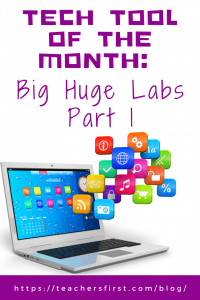Big Huge Labs is an online tool that allows students to create personalized content using images and adding their own text. Currently, Big Huge Labs includes over 20 excellent tools to create a magazine cover, an inspirational poster, a map maker, a trading card creator, and more. No registration is required. However, you can save your projects and print them in a higher resolution if you register. Big Huge Labs also includes an educator area with additional resources and activities. The free education account also allows your students to share projects with you. Read more about the educator account here.
Applying the Triple E Framework
The Triple E Framework, created by Dr. Liz Kolb, is built on the belief that “effective technology integration begins with good instructional strategies and not fancy tools” (tripleeframework.com). Dr. Kolb wrote a book on Learning First, Technology Second (ISTE, 2017) that lays out the three main uses for technology in education: to Engage, Enhance, or Extend learning goals. We can use this framework to decipher why we are using specific tools in the classroom. Here is a rubric based on the Triple E Framework you can use to evaluate whether Big Huge Labs (or any other technology) is a good fit with your learning goals and whether you should use it in your lesson.
- Engage in learning goals: The students are more focused on the task because they create images and add their original text. There are no badges, games, or other extras to distract from the process of learning. The students are active social learners as they create their images. The students are motivated to begin the learning process since they do their own projects with pictures and text.
- Enhance learning goals: Big Huge Labs allows students to use technology to make images and text projects. Students can create motivational posters, trading cards, and about 20 other image-related projects. The photos and additional written information allow students to demonstrate a more sophisticated understanding of the material. Students use higher-order thinking skills to organize their thoughts and words onto images.
- Extend learning goals: Dr. Kolb describes extended learning as an opportunity for students to learn, connect, and collaborate outside of the regular school day and bridge the school day and real-life experiences. Creating the image projects outside the classroom would fit with flipped, remote, or blended learning. These activities would make an ideal asynchronous learning experience. Independent work and media creation can help students build skills used in everyday lives outside of the classroom environment. We are preparing our students for a world that doesn’t exist yet, but most jobs require independent motivation and knowledge of technology.
SAMR Connection
The SAMR Model, by Dr. Ruben Puentedura, suggests that technology implementation has four levels. We can use this model as a guideline to analyze how we’re using technology tools in the classroom. For example, the activities found at Big Huge Labs can be at the level of Substitution, Augmentation, Modification, and Redefinition, depending on what students are doing. Let’s talk Let’s how we could take an activity (for example, creating a magazine cover) using Big Huge Labs and evolve this activity through the four levels of SAMR.
- Substitution: The substitution level is the most basic level of SAMR and refers to when technology acts as a direct substitute without any functional improvements. An easy example of this could be students using Big Huge Labs to create a magazine cover, rather than writing it on paper and stapling the pages together.
- Augmentation: At the level of augmentation, the technology acts as a direct substitute and includes some functional improvements. We could take our Big Huge Labs magazine cover to the level of augmentation by having students share their created magazine covers with their teachers using the automatic submission option available in the free Education version.
- Modification: The level of modification allows us to make (or modify) the activity into something more integrated with technology, meaning there is significant task redesign. Using the same magazine cover activity, we could use Big Huge Labs and move to the level of modification by having students share their projects with classmates on a Google Site.
- Redefinition: At the highest level, the technology allows for creating new previously inconceivable tasks. Returning to the example of the Big Huge Labs’ magazine covers, we could get to the redefinition level by having students participate in a Gallery Walk using Padlet. Students share their magazine covers and have an opportunity to comment on other students’ work.
Don’t miss Part 2 of the Tech Tool of the Month: Big Huge Labs, where we’ll discuss using the tool and classroom use ideas. In the meantime, let us know how you have used Big Huge Labs in your education setting in the comments below.


